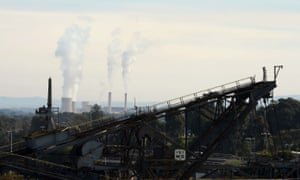The Grattan Institute has proposed adapting the Coalition’s Direct Action into a bipartisan policy that effectively cuts emissions

A climate change policy that could be both effective, and potentially supported by both major parties, has been proposed by the Grattan Institute in a new report that tries to find a pragmatic solution to the decade of toxic political debates on the issue.
Media reports have emerged suggesting Labor would adopt a policy of opening an inquiry into Australia’s energy industry, and shutting down the oldest and dirtiest power stations to lower emissions and create more demand for renewable energy.
The Grattan Institute report notes an economy-wide price on carbon would be the best possible policy– reducing emissions at the lowest possible cost – but it says a stable policy environment where successive governments stopped ripping up old policies and starting again was needed.
Without that, businesses could be reluctant to make long term investments in lower carbon technology, Tony Wood, lead author on the report told Guardian Australia.
“Pragmatism and urgency demand a practical, next-best approach,” Wood said.
Current Coalition Direct Action climate policies are projected to result in increased greenhouse gas emissions, albeit at a level that might allow Australia to meet its 2020 targets because of accounting rules. But new or strengthened policies would be needed to meet the 2030 or 2050 targets, the report finds.
Those policies came into effect after the Coalition was elected and ripped up the previous Labor government’s climate policies.
Meanwhile, the Labor party continues to have an emissions trading scheme at the centre of its policy, which would again result in wholesale change to the current policy framework.
The Grattan Institute report described this process as a policy bonfire and proposed a framework that “builds on the Coalition’s current climate policies while maintaining direction towards the long-term target”.
The report argues the government should take three steps.
- In addition to paying polluters to reduce emissions, the Direct Action policy includes a “safeguard mechanism” which can put limits on individual large polluters. The report argues these limits should be strengthened, forcing reductions on the big emitters in line with Australia’s targets.
- In order to make sure the reductions are achieved at the lowest possible cost, the report argues the government should auction tradeable permits that allow businesses to emit more, but still keep the overall national targets.
- Finally, to achieve zero net emissions, it argues the safeguard mechanisms should be expanded to cover smaller emitters too, and progressively reduce the allowed caps to zero, resulting in all emissions being a result of the tradable permits.
Wood didn’t call this an emissions trading scheme but noted in the report that the above plan “shows how a future Labor government could take the Coalition’s policy framework and move to its preferred emissions trading model”.
Advertisement
Today the Australian reported the Labor party was preparing to announce its carbon policies to take to the election, and they would include the launching of an inquiry into the electricity market, that could be charged with developing a plan to shut down the oldest and dirtiest coal-fired power stations.
In a speech to the Sydney Institute in March, Mark Butler, the federal environment spokesman for Labor, said it were considering this. He said in his consultations with a wide range of groups, including the electricity industry, there was widespread support for a policy would shut down the “the more heavily polluting older coal fired power stations in this country.”
“We are considering those views very closely at the moment as we finalise our election policy,” he said.
AGL, Australia’s biggest emitter and owner of some of the country’s dirtiest power stations, has called for just such a policy. Critics have suggested it would then look for compensation payments from the government. Such a policy would also increase wholesale energy prices for generators like AGL.
Conservation groups in Australia have supported policies that would shut down coal, because it will decrease the oversupply of electricity in the market, increasing demand for renewables .
Wood said such a policy could sit on top of the sort of policy his report advocated, but said it wasn’t the most efficient way to reduce emissions.
“The objective is to reduce our emissions in the lowest cost way” and a carbon price would ensure that, he said. “I can understand that if you can’t get a stable, predictable carbon price, then you do something … like regulation, but I think regulation is always the last card.”

